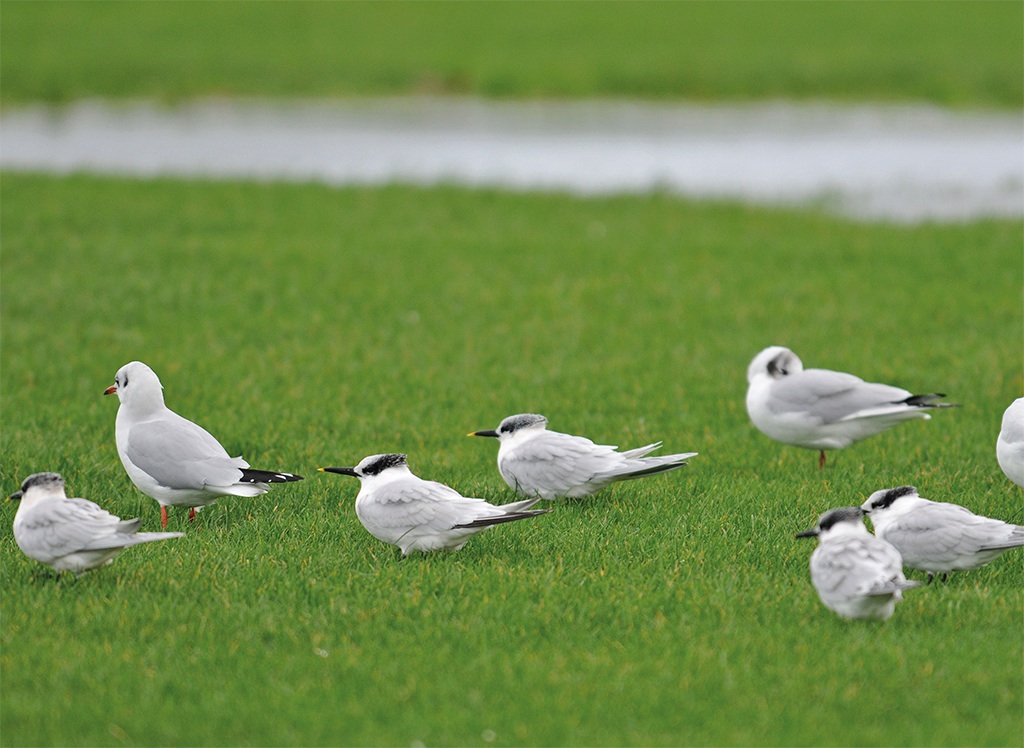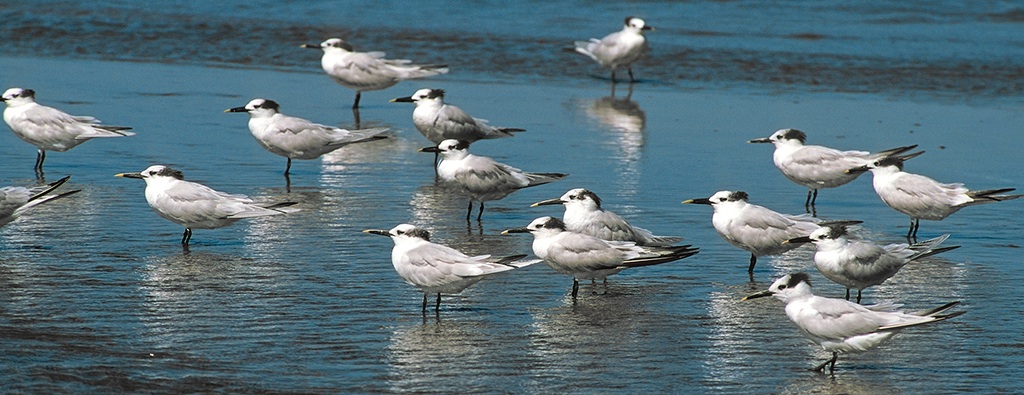It’s a miracle that Nick and I have actually finished writing this book together, and if it weren’t for Magnus acting as a buffer and editor, I would have either killed him or he me. From my point of view it’s not just the book, it’s also the birds. Take last month. Mo and I rented the cottage on Brownsea. It cost us over a thousand pounds for a week, but I argued it looked perfect for a rarity. There was a full moon, we were in September, and a hurricane had just left North America. We took up residence on the Thursday night, but knowing that we would have to go to a meeting on Monday and Tuesday, I called Nick and asked if he would like to come over and bird the days we couldn’t do. In fact he came a couple of days early with Claire. We had a lovely time, drinking wine and watching the birds. Then the minute I was gone, he found the harbour’s first Buff-breasted Sandpiper, which stayed for only two hours. Fortunately Nick had also gone by the time I got back!
It was lovely staying there though. Huge numbers of birds use the lagoon in a day. One night I went out, and there were over 4,000 gulls roosting up against the wall. On that day, I reckoned that at least 9,000 birds were using the lagoon. One of the most interesting was a group of 24 Arctic Terns driven in for a few days. They are uncommon in Poole.
When the Dorset Wildlife Trust took over the reserve at Brownsea, one of the aims was to encourage terns to breed. The first tern islands were finished in 1963, and within a decade Sandwich Terns had a go at nesting. The single nest in 1972 was deserted. Then in 1973, 23 pairs produced 25 young. In what was to become a familiar pattern, the following year nesting attempts failed when a local Sparrowhawk made regular visits. Since then, the population has become nationally important with around 230 pairs.

Sandwich Tern Sterna sandvicensis (showing characteristics of Cabot’s Tern S acuflavida), Baiter, Poole, Dorset, 30 November 2009 (Nick Hopper)
Sandwich Terns migrate south to winter off West Africa and beyond. The odd bird occasionally stays, but most have usually gone by the beginning of November. Nick specialises in finding those that hang round. I first learnt this when he was driving on a January bird race and suggested calling in to see if a Sandwich Tern was about. We were rather short of time, and I then made one of my most vulgar and regrettable comments. “If there is a Sandwich Tern here Nick I’ll eat my own shit.” We pulled into the car park and there on the mud, right in front of us, was one.
In 2009, in mid-November, a couple of weeks after apparently seeing the last ones off, there was a long spell of bad weather and Nick found 10 new Sandwich Terns in the harbour. Given the run of southwesterly depressions, he was hoping that one of them could have been blown across the Atlantic and would turn out to be Cabot’s Tern Sterna acuflavida (CD1-34), a recent split from Sandwich Tern (CD1-35), but still regarded as a subspecies at that time.
CD1-34: Cabot’s Tern Sterna acuflavida San Padre Island, Texas, USA, 26 April 1999. Two cuts of advertising calls, passing overhead. Background: Least Tern Sternula antillarum, Caspian Tern Hydroprogne caspia, Royal Tern Sterna maxima and Laughing Gull Larus atricapilla. Btlg02.MC.01925.31
CD1-35: Sandwich Tern Sterna sandvicensis Griend, Friesland, Netherlands, 18:00, 15 April 2006. Advertising calls and ‘barking’ calls of several adults passing close overhead. Background: Eurasian Oystercatcher Haematopus ostralegus and Black-headed Gull Chroicocephalus ridibundus. 06.005.MR.20000.011010
To identify Cabot’s Tern, you have to sort out the age and stage of moult. One of the diagnostic features of adult birds is thin white edges to the primaries that end short of the tip, compared with the much thicker edges of Sandwich Terns that continue to the tip. Nick found one showing these diagnostic features, but then when he remembered that immature Sandwich Terns also show this, he realised he needed to take a closer look.
Some time later, after several more visits he then found another candidate that was definitely an adult. This bird looked very interesting as it still had all its old primaries. According to BWP, all Sandwich Terns by the end of November should have completed or at least be well into their wing moult, whereas Cabot’s Terns do not complete their moult until early spring. It was certainly at the correct stage of moult for Cabot’s.
The head pattern was reasonable but the bill just didn’t look the right shape no matter what angle he tried looking at it. Have a look at the photo and see what you think. Before you make your decision however look at the picture taken by René of Cabot’s in Costa Rica. After what happened last time with Nick and Sandwich Terns, this time I won’t be commenting!
We’ve had a few rare terns on Brownsea. There have been a couple of fleeting visits by Caspian Tern, and an adult White-winged Tern was found on the lagoon by Alan Bromby the National Trust warden and Helen Brotherton on 15 June 1964. This species must surely be due for a return visit. Much less rare but frustratingly difficult to catch up with is Black Tern. Once every blue moon or so, they suddenly arrive in great numbers. Imagine the scene on 18 August 1952, when 1,000 Black Terns arrived on the beach in Studland Bay, accompanied by up to 3,000 other terns. On 24 August 1977, another flock of 130 arrived on Brownsea after heavy rain. Two days later, most had moved on.
Each year there is one prize bird to search for: Roseate Tern. For at least 50 years, there has usually been a pair or two hidden in among the Sandwich Terns in spring and summer. They are indisputably beautiful with their pink-flushed breasts and long tail streamers, and essential for all the birders’ year lists. They display most years, but the only firm evidence of breeding was in 1985, when one pair nested and subsequently deserted, and again very recently in 2010. Our birds may be wanderers from Irish breeding colonies, as an adult in 2003 had been ringed there.

Cabot’s Terns Sterna acuflavida, adults and first-winters, Dominical, Costa Rica, 12 January 2001 (René Pop)
Whether you see a rare tern or not, one of the best bird experiences you can have is sitting in the MacDonald hide in mid-summer and being surrounded by breeding terns. You can almost reach out and touch the Common Terns, also beneficiaries of the tern islands. They first bred in the harbour in 1951 and could hardly wait for the islands to be finished in 1963, when eight pairs bred. This grew to 90 pairs by 1970. Numbers continued to rise, and in 1990 the Brownsea breeding colony reached 130 pairs. By 1997 it was classified as nationally important. During the last 10 years, we have had anything from 180 to 246 pairs, raising 100 to 150 young.
This success is still precarious, and creating safe refuges for terns is like growing lettuces. Recently roosting cormorants have been treading on their eggs, and everything likes a nice tern egg or fledgling. Fortunately there are no foxes on Brownsea, which really helps. In the ‘60s and ‘70s it was the Herring Gulls that gave the most trouble, and to help protect the terns, the gulls were controlled by pricking their eggs. Which brings us to another puzzle. What is Britains rarest breeding bird, and breeding as it does on Brownsea lagoon, why is it in danger?